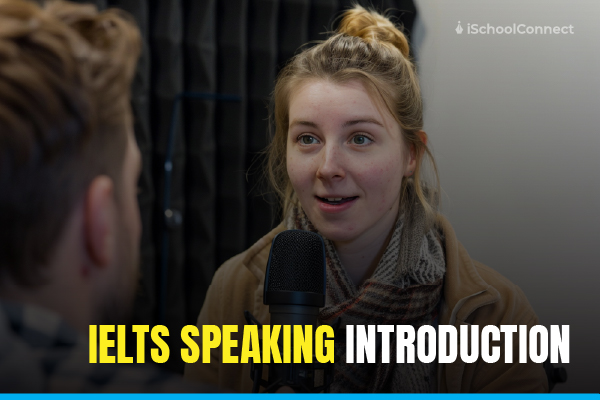Table of Contents
- Importance of Self-Introduction for IELTS Speaking
- How to Write a Self-Introduction for IELTS Speaking Test
- Common Questions in the IELTS Speaking Self-Introduction
- How Can I Start My IELTS Speaking Talk?
- Self-Introduction Sample for IELTS Speaking
- Mistakes to Avoid in Self-Introduction
- IELTS Speaking Practice Makes Perfect
- Summary
- FAQs
The IELTS Speaking test is your chance to make a strong first impression by confidently sharing details about yourself. Think of it as a friendly conversation where you showcase your ability to communicate clearly and effectively. In this guide, we’ll explore how to structure your self-introduction to ensure it’s engaging, concise, and well-suited for the IELTS evaluation criteria.What is the IELTS Speaking Test?
The IELTS Speaking Test is an indispensable part of the International English Language Testing System (IELTS). This section of the test is specifically structured to assess various aspects of speaking ability, including fluency, coherence, lexical resource, grammatical range and accuracy, as well as pronunciation.
The test is divided into three parts:
- Part 1: Introduction and Interview (4-5 minutes)
In this section, the examiner introduces themselves, checks the candidate’s identity, and asks general questions regarding familiar topics such as family, home, work, studies, and interests.
- Part 2: Long Turn (3-4 minutes)
In this section, the examiner provides a task card with a specific topic and guiding points. This part assesses the ability to speak at length and structure ideas logically.
- Part 3: Discussion (4-5 minutes)
This section involves a deeper discussion related to the topic introduced in Part 2. The section assesses higher-level speaking skills like the ability to explain analyze issues, and opinions, and engage in abstract discussions.
Also check out: IELTS Cue Card
Importance of Self-Introduction for IELTS Speaking
A self-introduction is a critical component of the IELTS Speaking Test, serving as the initial interaction between the candidate and the examiner. It plays a significant role in setting the tone for the rest of the speaking assessment.
Also Read: How to Use Anecdotes in the IELTS Speaking Test?
This initial interaction is crucial as it allows the examiner to assess the candidate’s fluency, pronunciation, grammar, and vocabulary right from the start. A well-structured and natural self-introduction can alleviate nerves and establish a comfortable atmosphere for both the candidate and the examiner, thereby facilitating a smoother conversation.
Explore: Similes and metaphors | How to use in IELTS speaking test?
An effective self-introduction should cover several key components to provide a complete picture of the candidate. Typically, candidates are expected to include:
- Greeting
- Name
- Hometown
- Occupation or Studies
- Reason for Taking IELTS
How to Write a Self-Introduction for IELTS Speaking Test
A well-structured self-introduction helps demonstrate your English speaking skills and creates a strong foundation for the conversation that follows.
Here are some pointers that you can keep in mind for a good Self-introduction:
- Start with a Polite Greeting: Begin your self-introduction with a courteous greeting to establish a friendly rapport with the examiner.
- State Your Name Clearly: Clearly stating your name is essential.
- Mention Your Hometown: Sharing your hometown allows the examiner to learn a bit about your background, enhancing the connection.
- Talk about Your Occupation or Studies: Next, discuss your current occupation or academic pursuits.
- Discuss Your Hobbies or Interests: Sharing your hobbies or personal interests adds a personal touch to your introduction.
- Explain Your Reason for Taking the IELTS (Optional): Optionally, you can mention why you are taking the IELTS exam.
Thinking of studying in Canada, read: IELTS Band Requirement for Canada
Common Questions in the IELTS Speaking Self-Introduction
During the self-introduction phase of the IELTS Speaking Test, you may encounter several common questions. Being prepared for these can help you answer more confidently and effectively. Here are some frequently asked questions:
- What is your full name?
Sample Answer: “My full name is [Your Full Name], but you can call me [Your Preferred Name].”
- Where are you from?
Sample Answer: “I come from [City/Country], which is known for [mention a distinctive feature].”
- What do you do?
Sample Answer: “I am currently [your job/occupation] or “I am studying [Your Major] at [University].”
- Do you work or are you a student?
Sample Answer: “I am [working/studying]. I work as a [Job Title] at [Company Name] or “I am a student at [University/College], pursuing [Your Field].”
- What are your hobbies?
Sample Answer: “In my free time, I enjoy [list a couple of hobbies], which allows me to relax and unwind.”
By preparing responses to these common questions, you can approach your self-introduction with greater ease, which will ultimately enhance your overall performance in the IELTS Speaking Test.
How Can I Start My IELTS Speaking Talk?
Here are several strategies and tips on how to begin your IELTS Speaking Talk, particularly for Part 2, where candidates are required to speak continuously on a given topic.
Use Prepared Opening Phrases
Using a simple and effective opening phrase can help you transition smoothly into your talk. Here are some examples to consider:
- “The topic I’d like to discuss is…”:
- “Today, I want to talk about…”
- “Let me tell you about…”
Briefly Outline Your Points
After your opening phrase, consider giving a short overview of what aspects you will cover during your talk. This gives the examiner a preview and helps you organize your thoughts. For instance:
“I will focus on three main points: firstly, I will talk about…; secondly, I will explain…; and finally, I’ll conclude with…”
This approach not only aids clarity but also structures your talk effectively, making it easier for the examiner to follow.
Personalize Your Introduction
Adding a personal touch can make your talk more engaging. Begin by relating the topic to your own experiences or feelings. For instance:
- “Personally, I find this subject quite interesting because…”
- “I have had a memorable experience related to this topic, which happened when…”
Self-Introduction Sample for IELTS Speaking
Here is a sample self-introduction that demonstrates how to structure your response effectively for the IELTS Speaking Test.
To make yourself feel more prepared, study: IELTS Practice Paper
Mistakes to Avoid in Self-Introduction
A well-crafted introduction can establish a positive first impression and set the tone for the rest of the test. Here are several key mistakes to avoid during your self-introduction:
- Speaking Too Fast or Too Slowly
Maintaining a moderate pace is crucial. Speaking too fast can make it difficult for the examiner to understand you, while speaking too slowly may affect your fluency rating.
- Using Informal Language
Avoid using slang, colloquialisms, or overly casual expressions during your introduction. Always opt for polite and professional language.
- Inundating with Unnecessary Details
While it is important to provide enough information to give a clear picture of who you are, overwhelming the examiner with excessive details can be counterproductive.
- Memorizing Content
Reciting a rehearsed script can come across as robotic and unengaging. Instead, practice your self-introduction to allow for natural expression.
- Interrupting the Examiner
Respect the examiner’s speaking turn; do not begin your introduction until the examiner has finished asking you their questions.
IELTS Speaking Practice Makes Perfect
Achieving proficiency in the IELTS Speaking Test requires diligent practice and preparation. Below are some effective strategies and common mistakes to avoid during practice sessions
- Familiarize Yourself with the Test Format
Understanding the structure of the IELTS Speaking Test is essential. Familiarize yourself with the three parts: the Introduction and Interview (Part 1), the Long Turn (Part 2), and the Discussion (Part 3).
- Practice Speaking Regularly
Consistently engage in speaking practice to improve fluency and confidence. You can practice with friends, family, or language exchange partners.
- Use a Variety of Topics
The Speaking Test can cover a wide range of topics. Regularly practice speaking on diverse subjects such as travel, technology, health, and education.
- Simulate Test Conditions
To prepare effectively, conduct timed practice sessions that mimic the actual test environment. Set a timer for each part of the Speaking Test and try to complete your responses within the time limits.
Summary
The IELTS Speaking Test begins with a self-introduction, a crucial part where candidates create a strong first impression. This blog provides a detailed guide to structuring an engaging and concise self-introduction while maintaining formal yet conversational language. It covers essential components such as greetings, stating your name, mentioning your hometown, occupation or studies, hobbies, and optionally, your reason for taking the IELTS. Additionally, the blog explains the test’s format, emphasizing the importance of fluency, grammar, pronunciation, and coherence in responses. It includes practical tips, sample answers to common questions, and strategies for avoiding mistakes like speaking too fast or sounding rehearsed. Lastly, the blog provides actionable practice techniques to build confidence and improve performance, ensuring candidates are well-prepared for the IELTS Speaking Test.
Explore these too:
FAQs
Ques 1: What is the IELTS Speaking Test?
Answer 1: The IELTS Speaking Test is a part of the IELTS exam designed to assess your spoken English skills, including fluency, coherence, grammar, pronunciation, and vocabulary. It consists of three parts: Introduction and Interview, Long Turn, and Discussion.
Ques 2: Why is the self-introduction important in the IELTS Speaking Test?
Answer 2: The self-introduction is the first interaction with the examiner, helping you create a strong first impression. It allows the examiner to assess your fluency and confidence, setting the tone for the rest of the speaking test.
Ques 3: What should a self-introduction for IELTS include?
Answer 3: A good self-introduction should include:
- A polite greeting
- Your name
- Your Hometown
- Your occupation or studies
- Your hobbies or interests
- (Optional) Your reason for taking the IELTS
Ques 4: Can I personalize my self-introduction?
Answer 4: Yes, adding personal touches like sharing a unique aspect of your hometown or hobbies can make your introduction more engaging and memorable.






